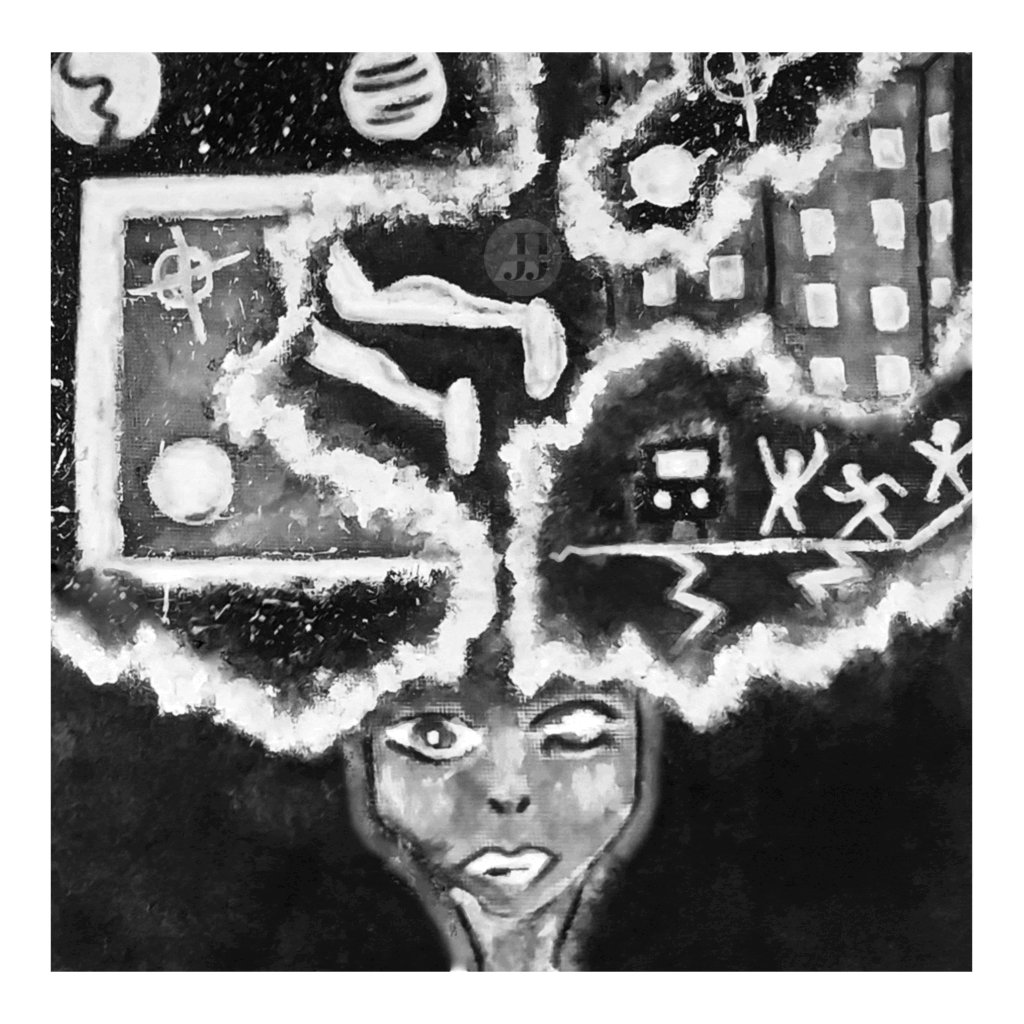The dormant seed of a soul, neither dead nor alive, is destined for an eternal journey; neither nourished nor deprived, lost in the hopeless melancholy of existence!!
Jubi Jia
This post is a visual and emotional interpretation of sleep paralysis, represented through an abstract black-and-white painting using traditional art techniques. The artwork embraces the contemporary chiaroscuro effect — an artistic play of light and shadow. If you’re curious about this technique, you can explore my other posts on chiaroscuro and how I experiment with it across various styles.
But today, our focus is on this particular piece, Dormant. It may not be my most technically refined work, yet it expresses a vivid and deeply personal dream — an unsettling episode of sleep paralysis.

What Is Sleep Paralysis? And What Sparked This Painting?
Sleep paralysis is a temporary state where the mind awakens before the body does, leaving you conscious but unable to move or speak, often when falling asleep or waking up. While commonly associated with narcolepsy or sleep apnea, it can happen to anyone. The experience is often terrifying. You’re trapped in a liminal space — aware yet frozen, awake yet still dreaming — making it difficult to distinguish hallucination from reality.
People who suffer from it often describe visions of dark figures, ghostly intruders, strange voices, or even a choking sensation. These hallucinations are not just sensory fragments — they can feel overwhelmingly real. Many cultures interpret them as encounters with spirits or demons. From my own experience, I can affirm the intensity of this belief. It feels as though your very soul is drained, invaded by a shadow that refuses to let you breathe. While science claims this state lasts for only a minute or two, it often feels like hours within the altered perception of a dreamer.
What’s worse, recurrent sleep paralysis can lead to sleep deprivation. And though deprivation is physically exhausting, it paradoxically opens inner creative pathways. My life has been shaped by such moments, when even sleep, once a safe haven, turns into a battleground. But it is from these haunting states that new art is born.
The Dream That Inspired “Dormant”
My hallucinations usually take the form of shadows, whispers, and ghostly presences — but “Dormant” was inspired by a different kind of dream.
It began with a scene that seemed ordinary: my brother and I packing our luggage into a car, just before sunset. We didn’t know exactly where we were going, but there was an air of adventure, a promise of a road trip. Then the dream blurred — suddenly I found myself asleep in a random motel room, much like scenes from The Matrix or Inception, where you fall asleep within a dream.
And then came the chaos.
An earthquake. Buildings collapsing. Screams echoing down an unfamiliar street. I was still lying in bed, trembling, paralysed. Yet in that moment of chaos, I opened one eye — and found myself waking into another reality.
I had two visions of the night simultaneously:
- One, a world in motion — the traffic lights blinking, people fleeing, the frantic rhythm of disaster.
- The other, a silent expanse of stars outside my window.
Two scenes unfolded at once, and I hovered between them. One part of me wanted to wake up into the dream and run with the crowd. Another part wanted to stay frozen under the silent, starlit sky. My body remained motionless, but my soul felt like it was leaping between dimensions — caught in a state neither of dreaming nor waking, fully alive yet completely dormant.
Real Aftershocks and Strange Coincidences
Some of you might have experienced similarly surreal states. What made this particular dream more unsettling was that the very next day, a moderate earthquake struck in and around my home state.
We live in one of the most seismically active regions on the planet, but such quakes are rare. It left me wondering: Was the dream simply a projection of internal fears, or did it hold a deeper connection with external reality?
I don’t claim to have answers. But it was a moment that blurred the boundary between dream and premonition, between hallucination and hidden truth.
Interpreting Dormant, the Experience — Between Shadows and Stars
Despite its traumatic intensity, I choose to look at this experience with a quiet kind of optimism. Unlike other episodes where I’ve felt possessed or attacked by dark entities, this dream seemed more like a psychological riddle, as if my mind was playing tricks on me during the delicate transition between REM and non-REM sleep.
Sleep paralysis is, after all, not only a scientific condition but also a symbolic terrain. It’s a space where the subconscious speaks — sometimes in symbols, sometimes in storms.
Eric Hoffer once wrote:
“Judgment consists not in seeing through deceptions and evil intentions, but in being able to awaken the decency dormant in every person.”
This line may seem unrelated to sleep paralysis, but in my interpretation, it fits. There were two competing forces in that moment — panic and peace. Fear and surrender. One chaos, the other stillness.
And I chose stillness.
I chose to take comfort in the silence of the starry night — in the infinite and unmoving sky above all noise.
Final Thoughts
Sleep paralysis is a terrifying experience — but also a deeply mysterious one. Through it, we sometimes glimpse not only nightmares but symbols, metaphors, and even truths. Dormant captures that liminality — that eerie stillness between two awakenings, two worlds, two versions of self.
And maybe, just maybe, there’s something sacred in choosing the stars over the storm.

